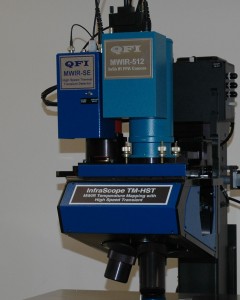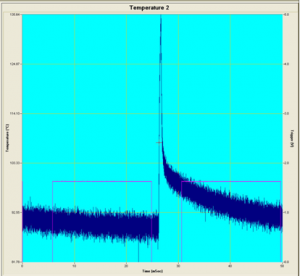Transient-IR MWIR High-Speed Temperature Trace Option:
QFI’s Transient-IR option makes use of an MWIR single-element, high-speed, thermal detector targeted at a single point to capture temperature data as a trace plotting temperature-versus-time. As an optional subsystem on the InfraScope™ MWIR temperature mapping microscope system, Transient-IR is optimized for investigation of thermal events transitioning at very fast rates. The system boasts 3-microsecond rise time resolution. Temperature-versus-time data is plotted as a trace on a software-integrated oscilloscope display. Automated emissivity correction and seamless integration with InfraScope™ imaging software ensures consistency and accuracy of data between these two techniques.
The detector output is fed to a high gain, high bandwidth preamp and digitized by a 16 BIT 100 Megasample/second digital scope board. In normal usage, the Transient-IR detector and the 2D MWIR imaging camera are co-aligned with the transient data capture targeted on the center of the temperature map image. The Transient-IR software integrates with the InfraScope™ imaging software. This co-alignment of sensors and integration of techniques saves steps by providing automatic emissivity correction for the Transient-IR solution. Instead of a device map, data is output as temperature-versus-time in an easy-to interpret oscilloscope format.
This Transient-IR technique has proven effective for measuring transient junction temperatures in RF devices and in MEMS devices such as ink jet print heads. Sensor is appropriate for both front side and backside probing.
QFI’s Transient-IR option is a single element, high-speed thermal detector, which is centered on the main InfraScopeTM temperature map image. The transient option uses the same optics and the same measurement set-up as the temperature mapping solution.
The single element can be digitized at very high rates.
You are welcome to request additional information via the information request link:


